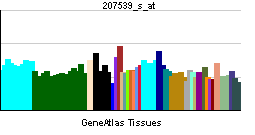Interleucina-4
| Interleucina-4 | ||||
|---|---|---|---|---|
 | ||||
| Estructuras disponibles | ||||
| PDB | ||||
| Identificadores | ||||
| Nomenclatura |
Otros nombres Binetrakina
| |||
| Símbolos | IL4 (HGNC: 6014) BCGF-1; BCGF1; BSF-1; BSF1; IL-4 | |||
| Identificadores externos | ||||
| Locus | Cr. 5 q31.1 | |||
| Patrón de expresión de ARNm | ||||
 | ||||
 | ||||
| Más información | ||||
| Ortólogos | ||||
| Especies |
| |||
| Entrez |
| |||
| Ensembl |
| |||
| UniProt |
| |||
| RefSeq (ARNm) |
| |||
| RefSeq (proteína) NCBI |
| |||
| Ubicación (UCSC) |
| |||
| PubMed (Búsqueda) |
| |||
La interleucina-4 (IL-4)[1] es una glucoproteína del grupo de las citocinas, que pesa unos 20 kDa y producida por las células T de tipo 2 (Th2), basófilos, mastocitos y eosinófilos activados. Actúa como antiinflamatorio al bloquear la síntesis de IL-1, TNF-alfa, IL-6 y la proteína inflamatoria del macrófago.
La IL-4 participa en la regulación del sistema inmunitario en múltiple niveles. Entre otras funciones, promueve la diferenciación de linfocitos Th2, la proliferación y diferenciación de linfocitos B y es un potente inhibidor de la apoptosis. La IL-4 desempeña un papel importante en el desarrollo de enfermedades atópicas como el asma, la dermatitis atópica o la anafilaxis sistémica.
Función[editar]
La interleucina 4 tiene muchas funciones biológicas, incluida la estimulación de la proliferación de células B y células T activadas , y la diferenciación de células B en células plasmáticas . Es un regulador clave en la inmunidad humoral y adaptativa . IL-4 induce el cambio de clase de células B a IgE y regula al alza la producción de Complejo mayor de histocompatibilidad (MHC) de clase II . IL-4 disminuye la producción de células Th 1 , macrófagos, IFNγ y células dendríticas IL-12 .
Inflamación y reparación de heridas[editar]
Los macrófagos tisulares desempeñan un papel importante en la inflamación crónica y la reparación de heridas . La presencia de IL-4 en tejidos extravasculares promueve la activación alternativa de macrófagos en células M2 e inhibe la activación clásica de macrófagos en células M1. Un aumento en la reparación de macrófagos (M2) se combina con la secreción de IL-10 y TGF-β que dan como resultado una disminución de la inflamación patológica. La liberación de arginasa , prolina , poliaminasas y TGF-β por parte de la célula M2 activada está relacionada con la reparación de heridas y la fibrosis.[2]
Receptor[editar]
El receptor de la interleucina-4 se conoce como IL-4Rα . Este receptor existe en 3 complejos diferentes en todo el cuerpo. Los receptores de tipo 1 están compuestos por la subunidad IL-4Rα con una cadena γ común y se unen específicamente a IL-4. Los receptores de tipo 2 consisten en una subunidad IL-4Rα unida a una subunidad diferente conocida como IL-13Rα1 . Estos receptores de tipo 2 tienen la capacidad de unirse tanto a la IL-4 como a la IL-13, dos citoquinas con funciones biológicas estrechamente relacionadas.[3]
Bibliografía[editar]
- ↑ OMS,OPS,BIREME (ed.). «Interleucina 4». Descriptores en Ciencias de la Salud. Biblioteca Virtual en Salud.
- ↑ Jon Aster; Vinay Kumar; Abul K. Abbas; Nelson Fausto (2009). Robbins y Cotran Base patológica de la enfermedad (8ª ed.). Filadelfia: Saunders. pag. 54. ISBN 978-1-4160-3121-5.
- ↑ Maes, Tania; Joos, Guy F.; Brusselle, Guy G. (2012-09). «Targeting Interleukin-4 in Asthma: Lost in Translation?». American Journal of Respiratory Cell and Molecular Biology (en inglés) 47 (3): 261-270. ISSN 1044-1549. doi:10.1165/rcmb.2012-0080TR. Consultado el 17 de mayo de 2023.
- Kay AB, Barata L, Meng Q, et al. (1997). «Eosinophils and eosinophil-associated cytokines in allergic inflammation.». Int. Arch. Allergy Immunol. 113 (1-3): 196-9. PMID 9130521.
- Marone G, Florio G, Petraroli A, de Paulis A (2001). «Dysregulation of the IgE/Fc epsilon RI network in HIV-1 infection.». J. Allergy Clin. Immunol. 107 (1): 22-30. PMID 11149986. doi:10.1067/mai.2001.111589.
- Marone G, Florio G, Triggiani M, et al. (2001). «Mechanisms of IgE elevation in HIV-1 infection.». Crit. Rev. Immunol. 20 (6): 477-96. PMID 11396683.
- Maeda S, Yanagihara Y (2001). «[Inflammatory cytokines (IL-4, IL-5 and IL-13)]». Nippon Rinsho 59 (10): 1894-9. PMID 11676128.
- Izuhara K, Arima K, Yasunaga S (2003). «IL-4 and IL-13: their pathological roles in allergic diseases and their potential in developing new therapies.». Current drug targets. Inflammation and allergy 1 (3): 263-9. PMID 14561191. doi:10.2174/1568010023344661.
- Copeland KF (2006). «Modulation of HIV-1 transcription by cytokines and chemokines.». Mini reviews in medicinal chemistry 5 (12): 1093-101. PMID 16375755. doi:10.2174/138955705774933383.
- Olver S, Apte S, Baz A, Kienzle N (2007). «The duplicitous effects of interleukin 4 on tumour immunity: how can the same cytokine improve or impair control of tumour growth?». Tissue Antigens 69 (4): 293-8. PMID 17389011. doi:10.1111/j.1399-0039.2007.00831.x.
